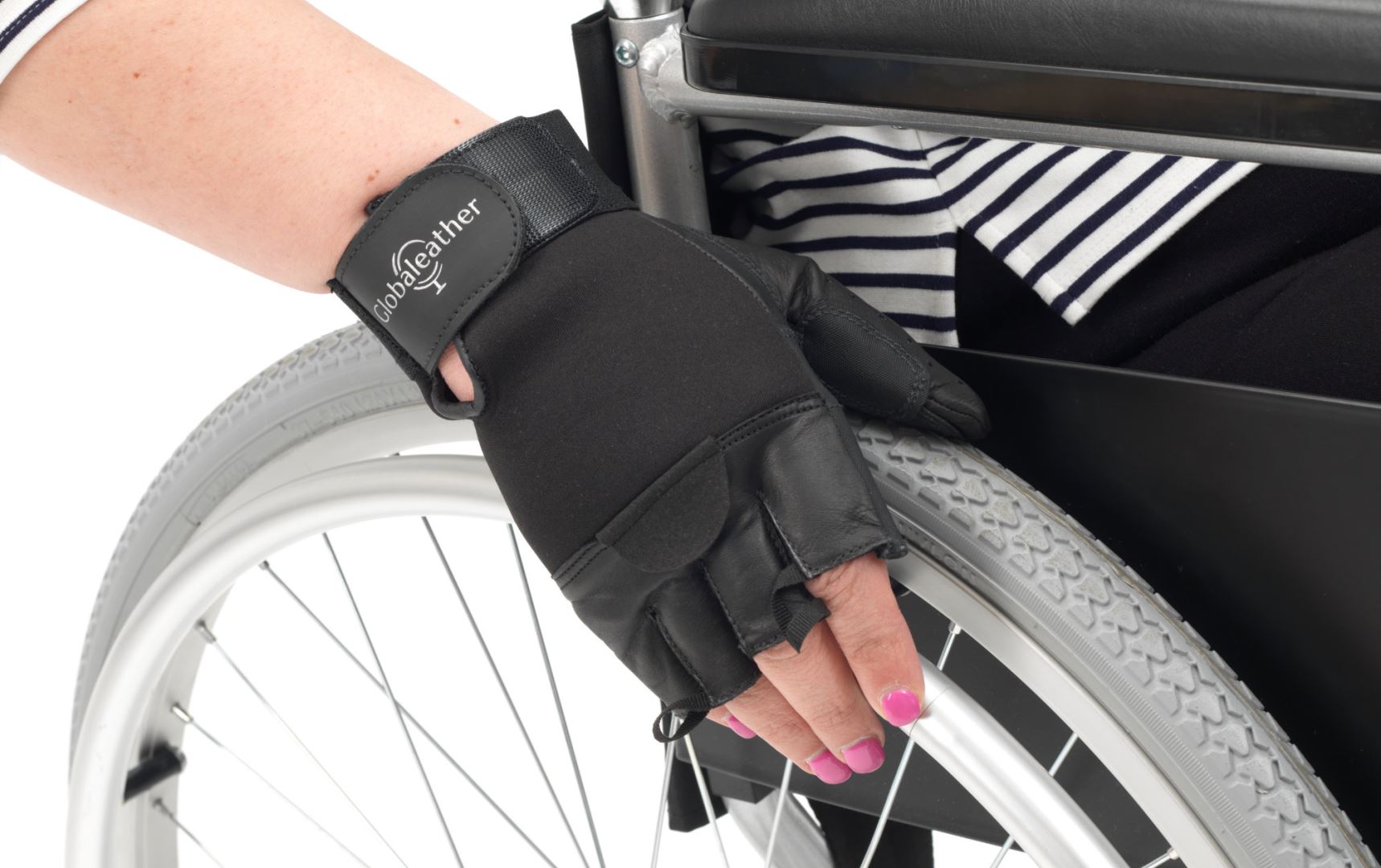Do you want to improve your mobility and control when using a wheelchair? Wheelchair gloves can be a great way to increase your dexterity and reduce strain on your hands while providing reliable grip.
In this article, we offer the complete guide on wheelchair gloves, so you can make an informed decision.

The traditional manual wheelchair is an essential mobility aid for many people with physical disabilities. However, operating a wheelchair requires a great deal of hand strength and dexterity, often resulting in pain and difficulty in the hands and wrists.
Wheelchair gloves are a beneficial tool that can help improve grip on the wheels and reduce wrist strain. This guide provides an overview of the types of wheelchair gloves available, important considerations in choosing the right pair, and how to best use them as part of your daily routine when using a manual wheelchair.
Explanation of what wheelchair gloves are
Wheelchair gloves are specialized recreational and medical tools designed to improve the safety and efficiency of individuals using wheelchairs. The gloves are made with a combination of durable materials, often featuring protective padding and strong grips to help control the user’s chair. They come in various lengths, styles and sizes so that they can be comfortably fitted to the user without hindering their movements.
These gloves are specifically designed for wheelchair users, providing protection against wear and tear while enabling them to easily control the chair. They also help protect hands from blisters and scrapes as well as preventing skin irritation from wheelchair brackets, armrests and other metal elements. By providing a cushion between their hands and the wheelchair’s metal parts, these gloves make the control of wheelchairs easier on the user’s joints and muscles. Furthermore, for those who use wheelchairs for outdoor activities such as sports or recreation, these gloves will help improve their grip on the wheels even in wet weather conditions.
Aside from providing extra protection whilst in motion, these specialist wheelchairs gloves can also offer comfort when accessing everyday items such as computer keyboards or telephones. In this way they can aid individuals with limited hand dexterity by allowing them more control over how they grip everyday objects. As such, use of these gloves can help support independent living whilst maintaining safe control over wheelchairs at all times.
Importance of using wheelchair gloves for protection and control
The use of wheelchair gloves is important for wheelchair users for several reasons: protection, increased control, and improved grip. Properly fitted gloves protect hands from blisters and abrasion caused by repetitive contact with the wheelchair tires or handles. Glove materials such as nylon, leather, or cotton can help absorb perspiration and provide insulation from cold or wet surfaces.
Wheelchair gloves are also purpose-built for increased hand control and better grip on the tire. This helps reduce fatigue in the hands due to continual pushing of a manual wheelchair, or gripping too tightly to avoid slipping off the handlebars. Specialized gloves provide improved gripping power on the tire and handlebars, allowing you to take your hands off without losing control of your chair.
Finally, well-fitted gloves also provide added comfort while using your wheelchair by cushioning hands against hard surfaces and relieving pressure points that may cause discomfort after extended use. It’s important to pay attention to glove size (small, medium/large) when selecting a pair of gloves — ones that fit properly will stay in place even during vigorous exercise or movement in the chair.
In conclusion, using properly fitted wheelchair gloves offers many benefits including protection from blisters and abrasions; enhanced hand control; improved gripping power on tires and handlebars;less fatigue; greater comfort during extended use;and insulation from cold surfaces or wet weather conditions. Regardless of what type of material you choose — nylon, leather or cotton — select a pair that snugly fits your hands for maximum benefit when maneuvering in a manual wheelchair.
Choosing the Right Wheelchair Gloves
The right kind of wheelchair gloves can make life much easier and more comfortable. Proper fit and adequate padding will provide protection while also allowing superior grip and control of your wheelchair. Wheelchair gloves come in a variety of styles, materials and sizes. When choosing your gloves, there are several factors to consider: size, comfort, durability and style.
Size: You want to find gloves that fit snugly yet allow for flexibility when gripping the wheels or pushing your wheelchair. If the glove is too loose, it won’t provide sufficient protection or control; if it’s too tight, it won’t be comfortable enough to wear for long periods of time. You may require different sizes for each hand — many gloves come in multiple sizes for a better fit.
Comfort: It is important to select a glove that is soft, padded, breathable and sweat-resistant so you can stay comfortable all day long. Look for details like anti-microbial protection – if you plan to use these gloves daily – as well as thumb loops or extra straps that keep them securely on your hands during rigorous activities.
.jpg)
Durability: Look for durable materials such as leather or reinforced stitching that will ensure the longevity of the product while also providing superior grip when needed. Select materials that are resistant to dirt and moisture so cleaning isn’t an issue later on down the line – this will save both time and money in the long run.
Style: Last but not least, choose a style of glove that reflects you – whether professional black leathers or popular colored neoprenes! Having a variety of styles available adds convenience by allowing you to choose appropriate attire for different occasions or activities without compromising on quality.
Factors to consider when selecting wheelchair gloves
When selecting wheelchair gloves, there are many factors to consider as no one glove will work for all users, so you must take into account the size, material, and shape of your hands and needs. Different levels of care and maintenance exist for various types of wheelchair gloves, so it is important to do adequate research before settling on a pair.
Size: Wheelchair gloves can come in a wide range of sizes for both men’s and women’s hands. Make sure to measure the circumference of your hand at its widest point to ensure you have an accurate fit. It is important that the gloves fit snugly without being too tight or bunching up around the knuckles as this can lead to discomfort when using the wheelchair.
Material: When looking at different types of materials used in making wheelchair gloves, you should consider how they feel on your skin and how easy they are to clean. Leather is generally considered a good option due its breathability, ease of cleaning, durability, comfort when gripped onto wheelchairs surfaces, and ability to form-fit better over time. Additionally, synthetic materials such as spandex or neoprene may provide more flexibility while still providing the necessary protection from rough surfaces found on wheelchairs.
Shape: Lastly, comfort should be factored in when selecting a pair of wheelchair gloves as you will be wearing them for long periods throughout the day; thus it is important that their shape allows gripping objects easily without pinching or slipping off frequently–especially during highly active tasks such as mobility drills or transfers between seating surfaces
Proper sizing and fit
Proper sizing and fit of wheelchair gloves is very important in ensuring the best results. Wheelchair gloves should be sized just like regular gloves, measuring around the knuckles and thumb on your dominant hand. Depending on your measurements, you may need to order a special size that fits better. When trying out a new glove it should fit well enough that it can move with your wrist, but not be so loose that it could slide off. Some manufacturers also offer adjustable wrist straps to create a custom fit.
When properly fitted, your wheelchair glove should provide good control of the chair while not putting too much pressure on your hands or wrists. Some gloves feature extra padding at the fingertips and knuckles to protect against contact with the wheel spokes or from bumping into various objects during use. Additionally, proper positioning of gloves on the hands is important for providing additional protection and optimizing control when driving a manual chair. Make sure you practice using them in a variety of different situations before wearing them for extended periods.
Testing out gloves before purchase
Before purchasing a pair of wheelchair gloves, it is important to test them for comfort and fit. Every person’s hands and fingers differ in size and shape, so it is important to find a pair of gloves that are tailored to you. They should also offer the necessary protection from bumps and scrapes. Here are some tips to help you find the perfect match:
– Try on several pairs of gloves with similar styles and sizes until you find one that fits best. Keep in mind the proper fit should feel snug but not too tight. There should be enough room at the fingertips for you to move them comfortably without pinching.
– Test how easy they are to get onto your hands by simulating how often you would need to take them off when transitioning from one activity or situation to another.
– Make sure they are flexible enough for both everyday activities such as driving or doing chores as well as more intense activities such as wheelchair sports.
– Check that they provide the adequate amount of grip — too much or too little can negatively impact your performance or cause slips and falls while transferring into or out of your chair.
– Test their durability by dealing with regular wear and tear such as dry cleaning, machine washing, folding, etc., so you know they can withstand long term use if necessary.
– Make sure there is ample padding across your knuckles so your hands feel comfortable when gripping users manual or automated control buttons in addition to allowing a better overall feel of steering movements.
III. Maintaining and Cleaning Wheelchair Gloves
It is important to properly maintain and clean wheelchair gloves to ensure they are in good condition and remain effective. Wheelchair gloves should be inspected before each use. If holes, frayed stitching, or signs of wear become apparent, replace the gloves immediately. It is also important to clean the gloves regularly in order to maintain their grip and durability over time.
To clean wheelchair gloves, remove all dirt and debris from the surface by hand or scrubbing with a soft brush. Next, mix warm water with a mild detergent solution such as laundry detergent or dish soap. Submerge the gloves, one at a time, for two minutes then rinse with clean water until soapy residue is gone. Allow them to air dry in a well-ventilated area away from direct heat or sunlight. Avoid using cleaning products containing bleach as this may cause discoloration or fading of certain materials used in the design of the gloves.
To extend the life of your wheelchair gloves it is important to follow manufacturer’s instructions regarding care and maintenance of their product. This may include periodic replacements due to excessive wear and tear as well as other tips such as avoiding direct contact with chemicals that could damage fabric material found on the glove surface. Proper cleaning and care helps keep your hands protected while allowing you to have better control over your mobility device.
Importance of cleaning gloves regularly
It is of utmost importance to take care of your wheelchair gloves regularly to ensure maximum performance and comfort. The regular cleaning and maintenance of your wheelchair gloves helps in preventing the build-up of bacteria, sweat, and other materials that can lead to skin irritation or worse. Regular cleaning also helps maintain the life and performance of your gloves, as dirt particles can accumulate over time and gradually reduce the levels of grip they provide while steering your wheelchair.
To clean your gloves, you can start by using a damp cloth or brush with an antibacterial soap to remove dirt and grime. When rinsing, use lukewarm water instead of hot water as this helps preserve the fabric’s quality. Finally, you should always lay them flat to dry in a well-ventilated area on a soft surface such as a towel to prevent stretching and wear down or discoloration due to direct sunlight exposure. If necessary, you could also use an iron set on low heat for a short period but be careful not to overheat as it may cause damage to your gloves.
Additionally, if washable instructions are stated on the glove packaging it is best for you follow those instructions for proper care.
Methods for cleaning gloves
Regularly cleaning wheelchair gloves is essential for maintaining their protective qualities and keeping them comfortable. To effectively clean gloves, follow these steps:
1.Remove your gloves, shake off any excess dirt or particles and lay them flat.
2.Dissolve a small amount of gentle clothing detergent in warm water (enough to create a soap suds) and submerge the gloves for a few minutes.
3.Using a soft brush, gently brush the gloves to remove any remaining dirt particles using circular motions and avoiding excessive scrubbing that could damage the material.

4.Rinse the gloves under cold water to get rid of any excess detergent and then dry them with an absorbent cloth or hang up in a place where they’re not exposed to direct sunlight or heat sources.
5.Once completely dry, reapply any anti-friction treatments or lubricants recommended by your glove manufacturer or healthcare professional if appropriate
6.Finally, store the gloves in a well ventilated area away from direct sunlight or other heat sources as prolonged exposure could damage them over time.
Conclusion
In conclusion, wheelchair gloves are a great way to ensure your hands are protected while you’re traveling. They provide a comfortable fit and can add both control and maneuverability when operating the wheelchair. They also work well as an accessory to add a bit of flair and style to your ride.
Wheelchair gloves come in various sizes and types, so you can choose one that best fits your needs. By taking into consideration the type of material, size, color, price range, breathability level and grip quality of your wheelchair gloves before making a purchase will help you decide which ones are right for you!
FAQs
What is the purpose of wheelchair gloves?
The purpose of wheelchair gloves is to protect the hands from blisters and calluses while propelling the wheelchair.
What are the best gloves for using in wheelchair?
The best gloves for using in a wheelchair are those that fit well, provide good grip, and offer adequate padding and protection.
What is the first safety precaution in using a wheelchair?
The first safety precaution in using a wheelchair is to ensure that the brakes are engaged before getting in or out of the wheelchair.
What is the uses of hand glove?
Hand gloves are used to protect the hands from injury, heat, cold, or chemicals, as well as for hygiene purposes.
What are the benefits of protective gloves?
The benefits of protective gloves include preventing hand injuries, reducing the risk of infection, and improving grip and dexterity.
What are the benefits of wheelchair accessories?
Wheelchair accessories can provide additional comfort, convenience, and safety for wheelchair users, as well as improve their mobility and independence.
Why are safety hand gloves important?
Safety hand gloves are important because they can protect the hands from cuts, burns, and other injuries, as well as prevent the spread of germs and bacteria.
What are wheelchair gloves made of?
Wheelchair gloves are typically made of materials such as leather, synthetic fabrics, or neoprene, and may have padded palms and fingers for added protection and comfort.
What gloves prevent hand injuries?
Gloves made of materials such as Kevlar, latex, or nitrile can help prevent hand injuries in certain work or recreational environments.
What are the four types of gloves?
The four types of gloves are disposable gloves, reusable gloves, cut-resistant gloves, and chemical-resistant gloves.
See Also-
- Best gel cushion for wheelchair 2023
- Best folding power wheelchair 2023
- Best cushion for wheel chair 2023
- Best wheelchair for seniors 2023
- Best dog wheelchair 2023


